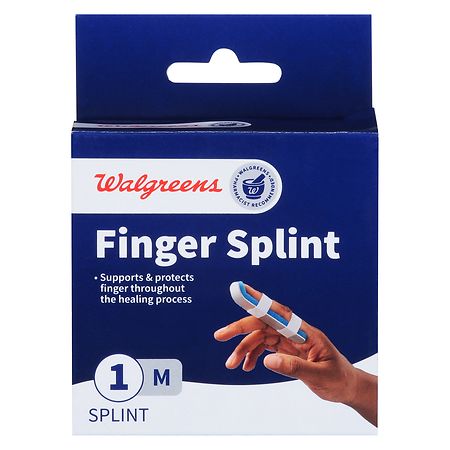Finger Splints
More information about Finger Splints
Your hands play an important role all day and every day. It’s no wonder that when you have an injury involving your hands, it seems like a huge inconvenience. Finger injuries are common in people of all ages. Over-the-counter splints and braces are available at Walgreens to help stabilize an injury. However, you should see your healthcare provider before treating the injury yourself. Your healthcare provider will be able to diagnose the injury, instruct you on how to appropriately treat the injury and determine if self-care measures are adequate for recovery.
What are finger splints used for?
Finger splints are typically used to stabilize an injured finger, prevent further injury and inflammation, and to provide support during the healing process. Some painful injuries or conditions involving fingers can include sprains, dislocations, broken bones, mallet finger and osteoarthritis.
Are there different types of finger splints for various injuries?
Finger splints are made of different materials and designed to fit different fingers and injuries. For example, a splint may be shorter to accommodate a thumb injury compared to a splint for other fingers. Certain types of injuries, such as De Quervain tenosynovitis, may be caused by repetitive movements, and this type of injury requires a specific brace. Although you may feel pain in your thumb, the injury may actually start in another location in your wrist. This is why it’s important to have your injury evaluated by your healthcare provider.
How long should you wear a finger splint?
Different injuries may heal faster than others. It’s best to follow all instructions given by your healthcare provider regarding the length of time needed for a splint or brace. Your provider may also tell you if you can take your splint off during certain activities, such as showering. People are usually instructed to wear a splint for a duration of two weeks to a month or longer.
Can finger splints be worn during daily activities?
Most finger splints are intended to be worn during daily activities to protect your finger and keep it immobile. However, some daily activities, such as showering, might not be possible with a finger splint.
How do I choose the right size and type of finger splint?
The right size and type of splint for your finger depends on the type of injury and its location. Your healthcare provider can help determine which splint or brace may be most appropriate for you. Be sure to wear your splint as instructed and tell your healthcare provider if you develop any sores on your skin, numbness or tingling in your finger, swelling or increasing pain. You may need a different splint or padding. If you need assistance in finding the correct and appropriately sized splint or brace, ask your local Walgreens pharmacist.
Are there specific instructions for wearing and caring for finger splints?
Always wear your finger splint as instructed by your healthcare provider, including the recommended length of time. Wearing your splint can help your finger heal more quickly and may help reduce complications. Finger splints are usually adjustable and should fit your finger securely but not too tightly. If a splint affects the color or sensation of your finger, you may need to loosen it. Let your healthcare provider know if this is an issue. You should be careful to keep your splint clean and dry since wetness may cause sores.
You can find many different types of splints and braces for fingers, wrists, feet and more at Walgreens. Most of these products are located in one area of the store for your convenience. However, it’s best to see your healthcare provider first in order to determine how best to treat your injury. You may also benefit from medications for pain or swelling, which are also offered over the counter at Walgreens.


 Walgreens
Walgreens








